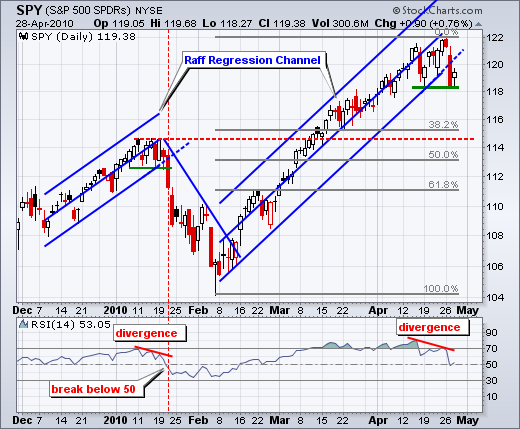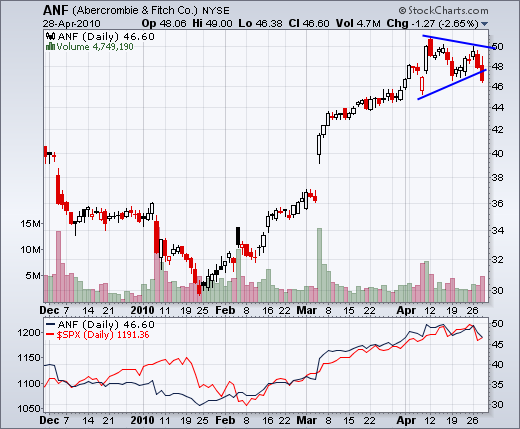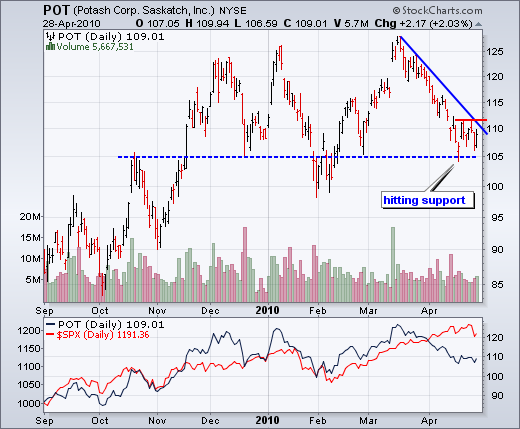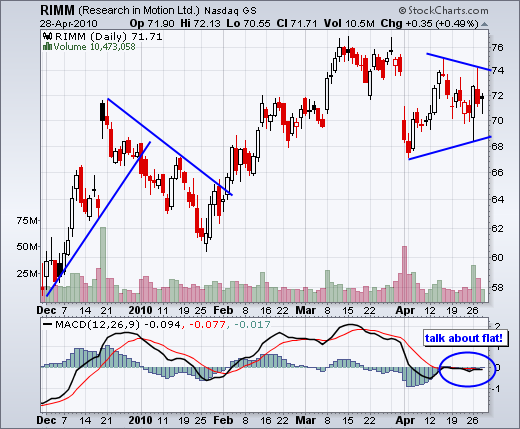That is the question. The S&P 500 ETF (SPY) became short-term oversold after a sharp decline on Tuesday and then firmed with an indecisive candlestick on Wednesday. Taken together, we have a harami or inside day. In addition, the ETF has support around 118.5 from last week's low and 118.25 from Tuesday's low. RSI is trading near 50, which provides momentum support in an uptrend. I do not see evidence of a major top right now, but a correction that retraces 38-50% of the Feb-Apr decline is a realistic possibility. If another "shoe" is to drop, I would expect it to drop in the next day or two. Pull backs within bigger uptrends can be short and sharp affairs. The first downside target would be broken resistance and the 38-50% retracement zone.


On the 60-minute chart, SPY fell to support with a sharp decline and then consolidated with a pennant. These are continuation patterns that form after sharp moves. A move below 118.5 would break pennant support and signal a continuation of the prior decline, targeting a move to the next support area around 116.5. An upside breakout is also possible so don't get too bearish just yet. Also don't forget that the bigger trend remains up. A move above 119.7 would argue for an oversold bounce, but I am not sure how far it will get.

Economic reports:
Thu - Apr 29 - 8:30AM - Initial Claims
Fri - Apr 30 - 9:45AM - Chicago PMI
Fri - Apr 30 - 9:55AM - Michigan Sentiment
Charts of Interest: AEO, ANF, CI, PBR, POT, RIMM






This commentary and charts-of-interest are designed to stimulate thinking. This analysis is not a recommendation to buy, sell, hold or sell short any security (stock ETF or otherwise). We all need to think for ourselves when it comes to trading our own accounts. First, it is the only way to really learn. Second, we are the only ones responsible for our decisions. Think of these charts as food for further analysis. Before making a trade, it is important to have a plan. Plan the trade and trade the plan. Among other things, this includes setting a trigger level, a target area and a stop-loss level. It is also important to plan for three possible price movements: advance, decline or sideways. Have a plan for all three scenarios BEFORE making the trade. Consider possible holding times. And finally, look at overall market conditions and sector/industry performance.

About the author:
Arthur Hill, CMT, is the Chief Technical Strategist at TrendInvestorPro.com. Focusing predominantly on US equities and ETFs, his systematic approach of identifying trend, finding signals within the trend, and setting key price levels has made him an esteemed market technician. Arthur has written articles for numerous financial publications including Barrons and Stocks & Commodities Magazine. In addition to his Chartered Market Technician (CMT) designation, he holds an MBA from the Cass Business School at City University in London.
Learn More





